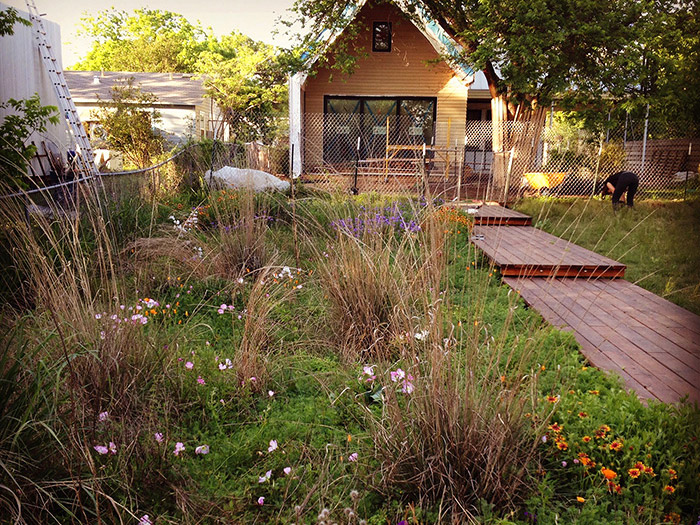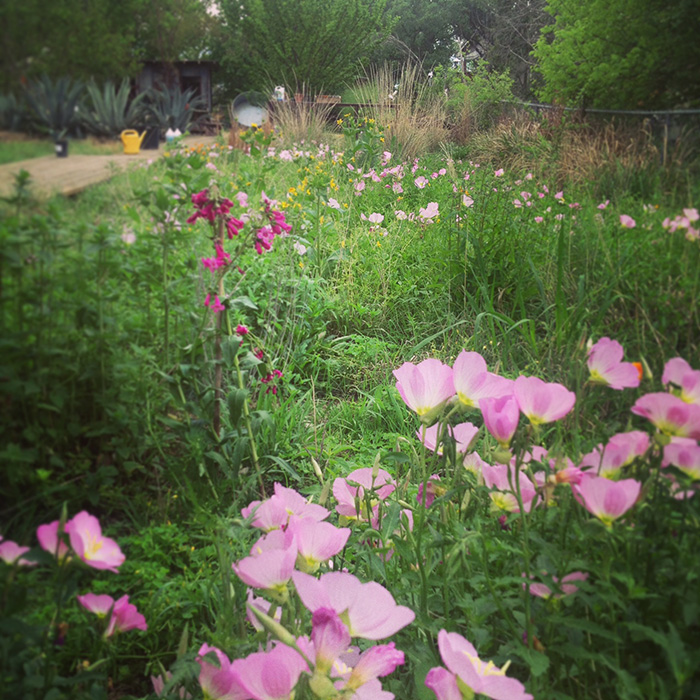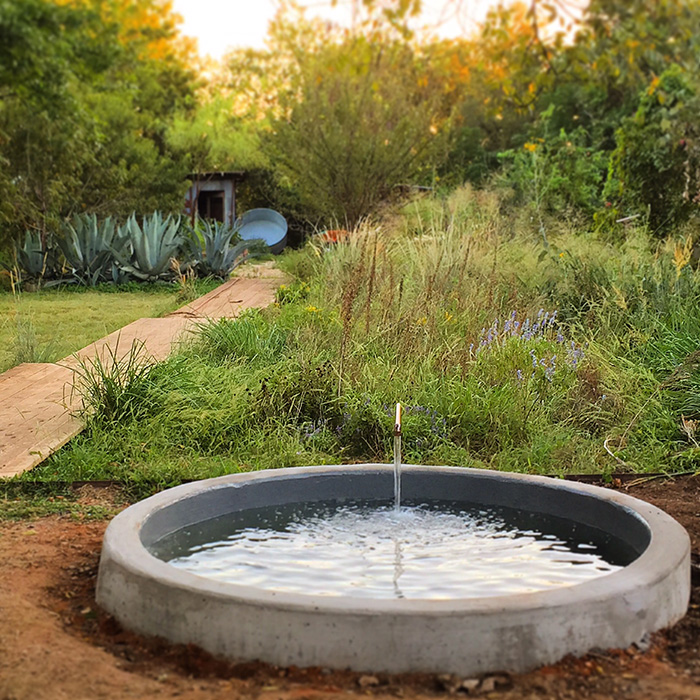Make a Pocket Prairie

Big muhly grass (Muhlenbergia lindheimeri) and little bluestem (Schizachyrium scoparium) intermingle with wildflowers in a pocket prairie at the East Austin home of John Hart Asher, a Wildflower Center environmental designer. PHOTO John Hart Asher
ARE YOU GREEN WITH ENVY when you visit the country and see that someone has so much land they’ve created a beautiful prairie at their home? Well, city folks: We’re here to tell you that you can have your urban ways and your prairie too.
“Few people realize that they have the power to sequester carbon, provide habitat for wildlife, prevent erosion and clean water by choosing to replace the norm — their non-native lawn or flowerbeds — with a prairie,” says John Hart Asher, environmental designer at the Wildflower Center. Asher created a pocket prairie at his East Austin home. Now he encourages others to do the same on their city or suburban lots.
Pocket prairies get their name by being relatively small and can be created in the smallest of spaces. But you wouldn’t want to create one in a space so small that it wouldn’t allow for the species diversity for which prairies are known. “Prairies are both species rich and species diverse,” Asher says. “So you want to make sure you have enough space to allow you to have a good amount of many different species.”
His pocket prairie is about 80 feet long by 100 feet wide. A challenge to creating a small prairie in an urban or suburban area is that you are likely to encounter a lot of “edge.” In other words, your prairie won’t be isolated from weed seeds in the way that a large rural prairie is. Since winds and birds are likely to carry them in, knowing what weeds are problematic in your area and what to look for is essential to giving your desired grasses and forbs a chance to thrive.
Not to worry, though. Before long, your little pocket of pollinator paradise will be a seed source, with visiting birds and prevailing winds taking seed with them to adjacent areas. Heck, if enough people nurture their own healthy landscape pockets, your city or urban suburbia could start to function like an urban preserve. And if enough people change their resource-dependent landscapes, cities could even help recover something such as Central Texas’ Blackland Prairie, one of the most endangered ecosystems on the continent.

Those translucent evening primrose blooms up close sure are gorgeous! A lone Hill Country penstemon (Penstemon triflorus) plant looms above some Texas cupgrass (Eriochloa sericea) and forbs not yet in bloom, including wild bergamot (Monarda fistulosa). Photos taken last spring; spring-season wildflowers and grasses are just starting to make an appearance this year. PHOTO John Hart Asher
Make a Pocket Prairie
1. Test your soil.
First thing you’ll want to do is mark out where you want your pocket prairie and test your soil for moisture, pH levels and soil type. This will give you good information for choosing which species to plant.
Prairie: An area dominated by grasses and forbs with almost no trees. Tallgrass prairie once extended from Canada to Central Texas!
Pocket prairie: A small prairie. Imagine if every yard from Canada to Texas had its own pocket prairie! How many birds and monarchs could be fed? How would it impact our air and bodies of water?
2. Know your region.
Once you’ve got a soil profile, determine when is the right time to plant for your region. (Here’s a link to discover your region.) A good rule of thumb is that you want to plant forbs in the fall because some wildflower seeds require winter weather to help weaken the seed coat and break dormancy. It’s better to plant grasses in the spring to give them a full growing season to get established and produce seed.
3. Buy the right seed.
It’s still safe to buy seed mixes that contain both forbs and grasses for planting either in fall or spring, but keep in mind some of the seed sown out of their ideal season may not do so well. Not to worry, you can always make up for any lost diversity by seeding or transplanting species later on.
What you must do is make sure your seed mix is actually of native species – not species that have naturalized. It’s wise to call any seed source to make sure the seed is truly native before you buy. There are plenty of native seed suppliers but if you have difficulty locating seed, try calling your local extension office or get in touch with a native plant society.
4. Prepare your soil.
Once you’re set with seed, you’ll want to prepare your soil before planting. You can follow our instructions for both soil preparation and planting here.
“The cool thing about prairies is there’s no right or wrong,” says Asher, who explains that prairies are disturbance ecosystems that needed fire and grazing to survive. “So, you can be a bit rough with your pocket prairie; it won’t need the gentle hand that a flowerbed does. And by that I mean that at any time after you’ve started your prairie you can get away with re-tilling areas to seed for more diversity, removing invasive plants, and moving plants around.”

A fountain is a welcome hardscape element in the yard’s design, serving as a water source to wildlife during hot, dry Austin summers. Asher created a small wetland with his by adding native freshwater fish and native wetland plants for them to feed on. PHOTO John Hart Asher
Embrace Change
Chances are that after the hard work that comes with preparing and planting your prairie you’ll want to relax and watch nature take its course. Although you can expect to see some plants taking root before too long, one of the biggest elements to establishing a mature prairie is time.
Different species will come in and out as your pocket prairie grows. You’ll learn which species are working where and bring in new ones. Asher says that prairies are the opposite of flowerbeds in that they constantly change over time as pioneer plants are replaced by later successional species. That change is part of their beauty.
“When Europeans first settled here, they wanted to impose order over this big, dark scary natural place that was seemingly devoid of logic, and this mentality shaped environments all over the world,” says Asher. “Now, we are at a point where we’ve done that to too much of our landscape and we are forced to relearn how ecosystems function. Prairies let us do that; they give us the chance to become an observer of natural processes and really start to learn.”
Related Stories:
